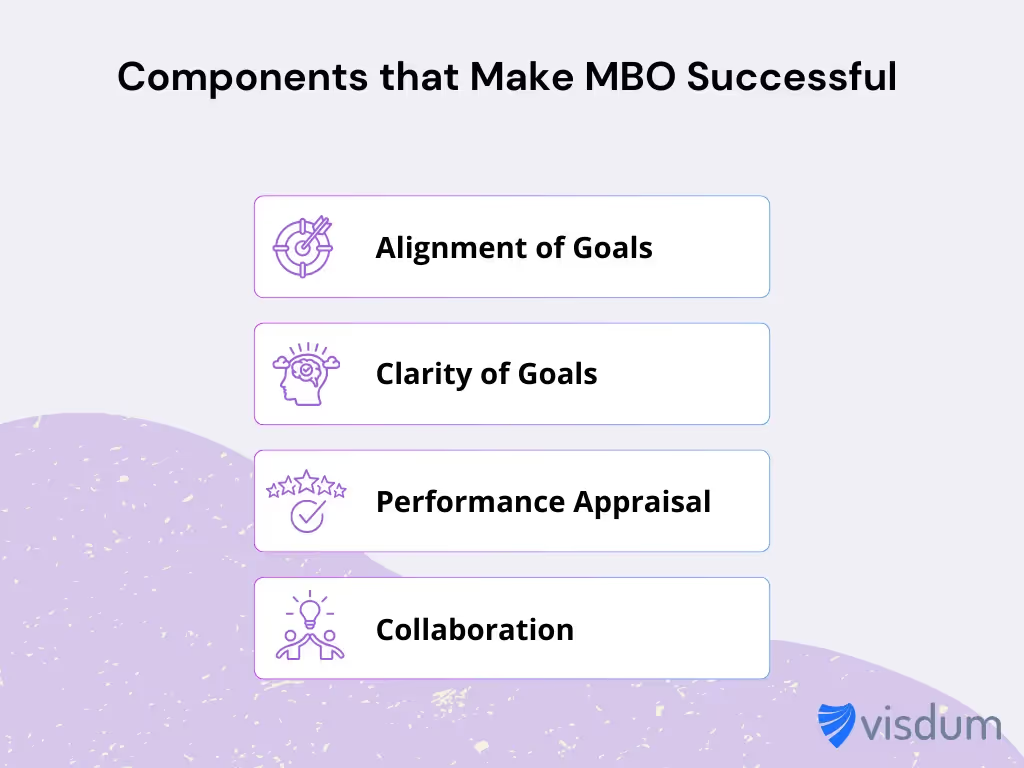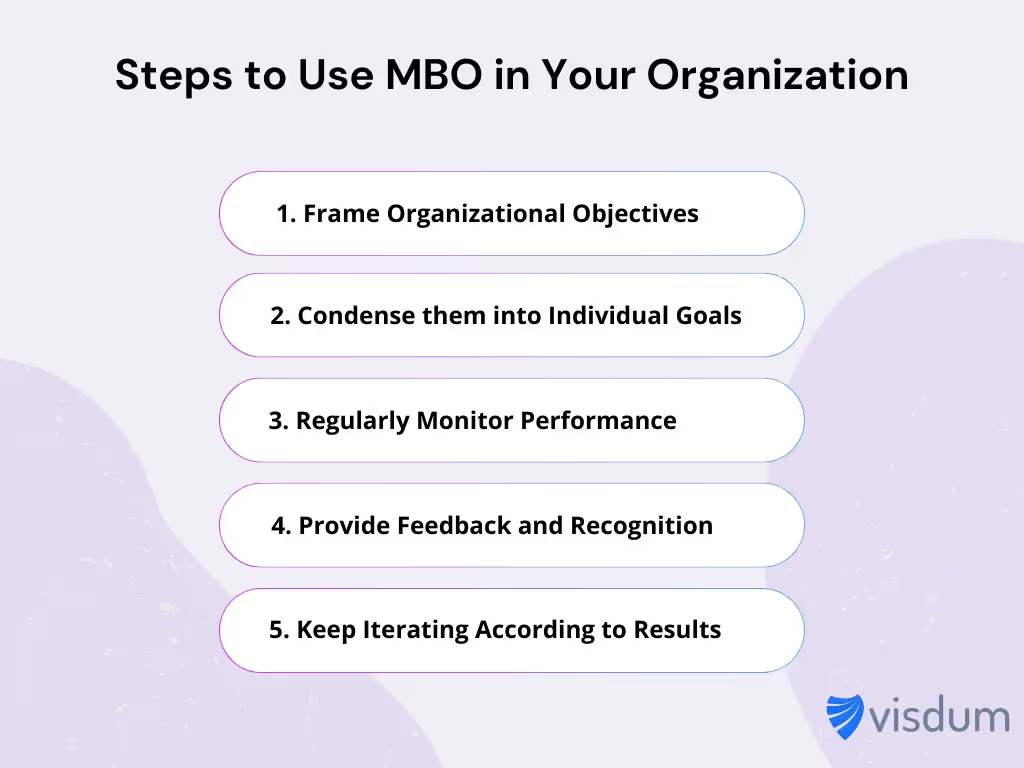What is MBO? Decoding Management by Objectives

Although MBO is now a widely used business term, when Peter Drucker has first coined the term ‘Management by Objectives (MBO)’ in his 1954 book ‘The Practice of Management’, the entire management realm was in for a surprise.
A study published in the Journal of Management found that organizations implementing MBO experienced an average productivity increase of 20% compared to those using more traditional management methods.
As an organizational management philosophy, MBO has triumphed for more than 50 years. It was the first philosophy that aimed to homogenize an organization's administrative and employee layers.
Come 2024, the MBO framework can still be a powerful weapon to boost performance. This rings especially true in target-oriented business disciplines such as sales, where implementing MBO can lead to significant gains. This blog dives deeper into how MBO can be implemented to access these gains.
What is MBO: Management By Objectives
MBO or Management by Objectives is a management strategy and goal-setting framework in which the managers and administrators work with the employees to set and achieve specific goals. MBO involves the employees in the organizational goal-setting process and promotes collaboration to achieve goals. MBO requires setting specific, achievable, and measurable goals for the employees, considering their inputs while paving the organizational growth path.
Key Features of MBO

To enjoy the full benefits of the MBO strategy, some key components are required:
- Alignment: The company goals should be clearly aligned to the individual goals. The employees should be aware of how their achievements translate into progress for the company.
- Clarity: Every employee should have clear and achievable goals. They should know exactly what they need to achieve in a specific time period (month or quarter), and the things that need to be done to achieve them.
- Monitoring: Employee progress should be regularly monitored and performance reviews should be conducted at regular intervals. This ensures that all employees are heading in the right direction, and have ample feedback to improve.
- Collaboration: In MBO, the employees guide the company into seeing what is realistically possible and what the best means to achieve it are. This ensures that unachievable goals are not in the picture. The individual goals are trickled down from the organizational objectives and are aligned to them. Performance is regularly reviewed and monitored, making iterations whenever the need arises.
How MBO is Used Across Departments
Now that we know about MBO and how it cohesively takes inputs from both employees and management, we are going to look at some examples of MBO usage to get a clearer understanding of the process.
MBO in Sales

Organizational Goal
Company A aims to increase its sales revenue by 30% in the current financial year. They trickle this goal down into individual performance goals with the help of the sales team members.
Individual Goals
- John, an account executive, has been assigned a sales quota of $30,000.
- Mary, an SDR, has been tasked with generating 50 new leads and closing 20% of all generated leads.
- Dave, the sales manager, is supposed to increase repeat sales by 20% by ensuring customer satisfaction and monitoring other reps’ performance.
MBO in Marketing
Organizational Goals
Increase inbound traffic by 30% for the website and generate 50 MQLs (Marketing Qualified Leads) per month.
Individual Goals
- Gary, a Content Marketer, is to perform thorough keyword research and put out 4 BoFu (Bottom of the Funnel) content pieces each month.
- Jane, an SEO Analyst, is supposed to optimize blogs (5 per month) and build backlinks (5 per month).
- Amy, another SEO Executive, is in charge of optimizing landing pages and reaching a 10% conversion rate on the company newsletter within the year.
- Sylvia, the Marketing Manager, ensures that there is 5k organic traffic per month and that at least 8 MQLs are coming in each week.
MBO in Human Resources
Organizational Goal
- Secure positive satisfaction reviews by at least 90% of the staff.
- Hire for 4 critical positions across departments.
- Conduct 2 team bonding exercises to promote satisfaction and cooperation.
Individual Goals
- Amanda, an HR executive, is tasked with the internal outreach for the employee satisfaction survey. Her goal is to secure reviews from at least 90 % of the staff.
- Grace, another HR executive, reaches out to potential venues and has to finalize the two events in their entirety.
- Steve, the Recruitment Lead, is tasked with conducting 8 interviews a month and closing the 4 open positions within 4 months.
How to Use MBO to Reach Organizational Goals

To any organization looking to introduce effectiveness in their organizational strategy, Management by Objectives (MBO) can prove to be a boon. The step-by-step process to implement MBO in your organization is as follows:
Step 1: Set SMART Goals
The first step is to take the mission and vision of your organization and condense it into organizational goals. One thing to keep in mind is that the goals should be SMART (Specific, Measurable, Achievable, Relevant, and Time-Based). This means that the goals are easily quantifiable and can be easily measured. Examples- Increase sales revenue by 30%, Launch a new product within a year, Increase lead generation by 20%, etc.
Step 2: Set Individual Performance Targets
After you have specific organizational goals, trickle them down into individual performance targets for the employees, and consult them regarding the efficacy of the targets. The organizational goals should trickle down to departmental goals, team goals, and individual goals at the end. The targets should be kept challenging but achievable. SMART goals should be used to ensure that there are clear action points to achieve the goals.
Step 3: Monitor Progress
When the action plans for achieving the goals are set in motion, continuously monitor the progress of each individual and department to ensure that the organization is heading toward the desired results. According to MBO, the goals should be measurable for the managers to monitor progress. If there is a lack of results in any team or any individual, consult them and review the problem. Adjust the goals if necessary. Conduct meetings and review sessions frequently for performance appraisal.
Step 4: Provide Feedback and Recognition
After monitoring the progress of the set goals, provide valuable feedback and recognition to the employee. Ensure that the ones who are performing well are rewarded and recognized effectively. Similarly, provide constructive feedback and ways to improve for those employees who aren’t performing well. Try to maintain open communication with the employees and figure out the reasons for underperforming or overperforming. This will lead to the betterment of the entire workforce.
Step 5: Iterate and Improve
Maintain cohesivity of goals and keep iterating. MBO strives for the usage of measurable and concrete goals, but the strategies needed to achieve those goals can be iterated and experimented upon. Because the goals are measurable, you will be able to gauge how well each strategy is working. Goals shouldn’t clash among themselves, and any employee should not be given additional tasks vastly different from his core responsibilities.
Advantages of MBO
MBO has many different advantages, as evident by the fact that companies still use it even after 70 years of its inception. Some of the main pros of using MBO as the goal-setting framework of the organization are:
- Clarity of goals: As MBO heavily emphasizes the usage of SMART (Specific, Measurable, Achievable, Relevant, and Time-Bound) goals, it leads to clarity and focus in the minds of the workers in terms of what they have to do, what goals they are aiming for, and how exactly they can achieve those goals. Clear goals leave no ambiguity in job descriptions.
- Enhanced Management: Regular performance monitoring and feedback sessions lead to more effective performance management. The supervisors and managers are always aware of what different teams are working towards, and how to measure their performance in objective terms.
- Improved productive communication: With regular feedback sessions and recognition programs, MBO ensures that there is a direct channel of communication regarding productive matters in a company. The employees always feel heard and are given feedback on how to improve their overall performance.
Disadvantages of MBO
Even though it was a revolutionary change in the field, MBO is not without its cons. The main disadvantages of using MBO as an organizational framework are:
- Overemphasis on individual goals: Individual goals are tracked and monitored closely, leading to a loss of will to cooperate and help others achieve their goals. Team spirit is hindered because of this emphasis on individual goals.
- Too much emphasis on objectivity: In the process of trying to keep everything objective and measurable, MBO strays away from endeavors that build company culture, bonds between the employees, a healthy work environment, etc.
- Difficulty in quantifying some areas: There may be issues in quantifying goals in certain areas of business. For example, measuring employee engagement and satisfaction is not possible without biases and external conditions, making accurate goal-setting impossible.
- Unregulated emphasis on performance leading to high-stress environments: Placing too much emphasis on quantified performance goals may lead the workers to use unfair means or become overly competitive, both instances that harm performance in the long run.
A Guide to Implementing MBO in Sales
As we have read so far, MBO and specific objectives go hand in hand. One business function that benefits the most from this fact is sales. In sales, the salespersons have different quotas they have to achieve in a defined period, and their entire compensation structure has fixed and variable components that depend on this quota.
Hence, sales lends itself perfectly to the implementation of MBO.
The steps needed to implement MBO in a sales team are:
Step 1: Set Overall Sales Goals
Set Sales Department Goals: The first step is to define sales goals from an organizational perspective. These goals can include sales revenue goals, number of new customers to acquire, repeat sales percentage targets, new market penetration percentage targets, etc.
Step 2: Assign Individual Sales Targets and Quotas
Set Individual Targets: According to your business goals mentioned in the previous step, set sales goals for individual staff members of the sales team and salespersons. An example would be that one person is focusing on customer interactions to encourage repeat sales, another is promoting a new product to his prospects, etc. with all of them having appropriately customized sales targets. SPIFFs can be used to tailor employee motivation toward specific goals. This ensures that the individual objectives are aligned with the company's goals.
Step 3: Monitor Progress
Monitor Progress: Keep a check on how each salesperson is doing. If they are not moving towards completion of their goals on time, there may be a problem of lack of proper sales incentives, unreal targets, etc. Consult them regarding the problem and address it. Sales commissions and other incentives are essential in driving sales performance.
Step 4: Provide Bonuses and Feedback
Reward and Recognize: Use additional incentives and bonuses to reward high performers. Accelerators and decelerators on sales commission earrings can also be used to model behavior and provide feedback.
Step 5: Iterate and Communicate
Ensure cohesivity and keep iterating: Ensure that the sales goals of different employees aren’t clashing together and aren’t so difficult that they cannot be achieved using ethical means. Keep looking out for advice from the sales team on how to improve the sales processes.

MBO vs. Other Strategies
In recent times, many other goal-setting frameworks and philosophies have been developed that have replaced MBO as the main driving force behind organizational goals. Some of these, in contrast to MBO, are:
MBO vs. OKR
MBO (Management by Objectives) and OKR (Objectives and Key Results) are both organizational goal-setting frameworks, the difference being the overall structure of the system. MBO is a more formal and structured approach that is used for achieving specific and quantitative goals, whereas OKR is a more transparent and flexible strategic approach that is used for reaching more aspirational goals. OKR boils down aspirations into key results that can be measured. OKR has more room for ambitious goals and maintains greater interpersonal connections by way of informal communication.
MBO vs. Six Sigma
Six Sigma is another organizational strategy to achieve desired performance outcomes. The main difference lies in the fact that Six Sigma aims to remove the defects in internal processes through the intensive use of data and statistical models. It is very resource-intensive and requires great attention to detail. Large modern organizations use this to make their processes more efficient.
The Bottom Line
MBO changed the organizational philosophies of many companies from a top-down perspective to a bottom-up approach. Rather than using the employees as tools for fulfilling the company’s goals, MBO introduced the change to actively include employees in the goal-setting process, and collaborate with them to reach combined goals.
The reason MBO became so widely popular was that it was the first philosophy that promoted the inclusion of employees. It led to higher employee satisfaction and motivation, which is why MBO works. Now, with more detailed research into management techniques, MBO is used as a base to build more customized organizational strategies.
FAQs
What do you mean by MBO?
MBO (Management by Objectives) is an organizational philosophy according to which employers and employees should work together in the goal-setting process for the organization. Also, the goals set should be SMART (Specific, Measurable, Achievable, Relevant, Time-Bound).
What are management objectives?
Management objectives are the organizational goals that a business entity is pursuing. They are directly related to their mission and their vision and are highly specific and measurable. An example of a management objective would be to increase sales by 20% in the next quarter.
What are the 4 steps of MBO?
The four steps of MBO are - 1. Set organizational goals and management objectives 2. Set individual performance goals and objectives 3. Monitor performance 4. Reward and recognize top performers. Following these steps will lead to organizational effectiveness.
What are the features of MBO?
The most important features of MBO are collaboration, measurability, and regular monitoring. The managers and team members work together to set goals that are specific and measurable, and the progress is regularly monitored and kept on track.
What are the principles of MBO?
The principles of MBO are SMART (Specific, Measurable, Achievable, Relevant, and Time-Bound) goals, Alignment of individual goals with the organization's objectives, and regular monitoring and feedback on performance.


.webp)
.webp)

